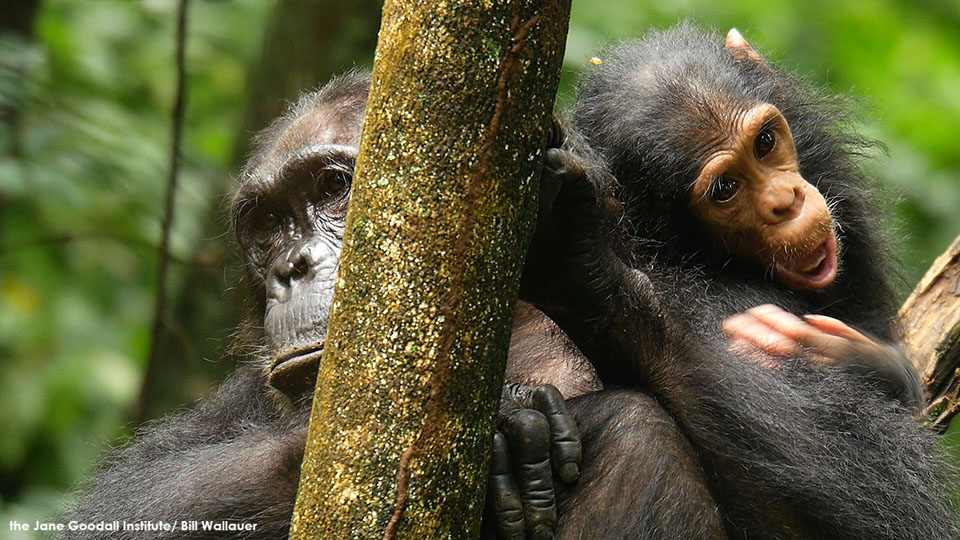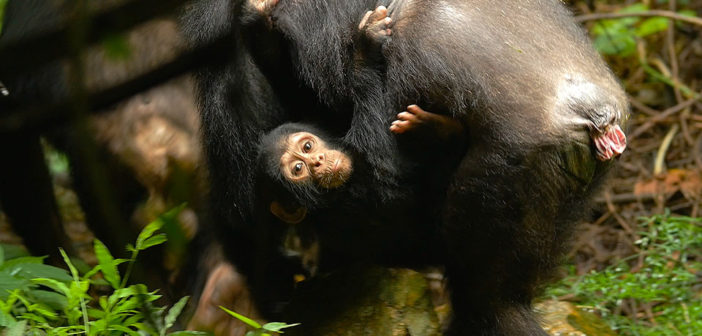CHIMPS POSTPONE PARENTHOOD, EAT MONKEYS & CATCH LETHAL COLDS
Good For All News - PRIMATES
BY ASHLEY SULLIVAN ON FEBRUARY 22, 2018
Genetically, chimpanzees and humans share 98.6% of our DNA, and our behaviours are more than a little alike as well. Our true relationship to the rest of the animal kingdom was redefined by a revolutionary woman of science, and for nearly 60 years since, Dr. Goodall’s research at Gombe has been evolving and continuing, much like our two chimp and human lineages, respectively. Insights from Gombe help us to better understand ourselves, what is ancient versus what is unique, as well as to reveal our similarities with the rest of animal-kind.
The following studies reveal the extraordinary chimpanzee research still being done today. There’s plenty to discover – are you curious?
Chimp Females Who Leave Home Postpone Parenthood
Recently, researchers at Duke University, as a part of the Jane Goodall Institute Research Centre, analysed over 50 years’ worth of daily records for 36 female chimps born in Gombe National Park, through the robust database which goes all the way back to Jane’s findings penned in her famous notebook. This analysis enabled researchers to see across time to uncover trends, which enabled them to find one surprising in particular: female chimps who depart from their birth family delay pregnancy and developing families of their own.
Chimpanzees live in groups with a structured hierarchy. In these groups, females can either remain with the group they’re born into or head out on their own, likely to reduce incidences of inbreeding. For a young female chimp looking to find her own way with a new group, her first pregnancy won’t happen until around the age of 16, whereas those who stay at home are moms at around age 13.
There are several reasons for this, including the support chimps who remain receive (which also means more access to food if their own mothers are high ranking) and the tough integration period for those who forge their own path. Results overall demonstrate how similar we are to chimps in general, with long development from child to adult. Yet, the question remains – should I stay or should I go now?
Meat Eating as Observed in Wild Chimpanzees
One of the wildest findings of Dr. Goodall that established an entirely different lens through which we see our closest living relatives, is evidence of meat eating and hunting in chimpanzees. Since her initial observations, researchers have witnessed chimps hunting and eating a variety of vertebrates, and in very rare cases, demonstrating cannibalism. Now, researchers want to better understand the meat eating compulsion in chimps, as they are predominantly herbivores (eating plants). So, things got a bit messy.

Researchers filmed 29 arboreal monkeys as they were consumed by chimpanzees at Gombe National Park, Tanzania, and recorded the order in which areas of the monkeys were consumed. The chimps generally consumed the heads of infants first, 91% were consumed this way, while adult monkeys were generally consumed torso first. The scientists suggest this has to do with physiological barriers: infant skulls are less developed and thus easier to break, while adult skulls introduce a challenge and their torsos contain a “ fat-rich liver”.
The findings give proper direction which could provide answers when it comes to the nutritional value of various organs, as well as inquiries around the overall benefit or necessity of meat eating in primates.
Lethal outbreak Among Wild Chimpanzees in Uganda Caused by Human “cold” Virus
In 2013, five chimps in a community of 56 in Kibale National Park, Uganda, died with little explanation. Researchers observed “severe fits of coughing and sneezing” in the chimps prior, and decided to investigate. Luckily, a vet on the scene was able to obtain samples postmortem to reveal what was going on. The chimps were stricken with Rhinovirus C, a variation of the human “common cold”, which was only discovered in 2010. The strain affects children mostly, usually as a precursor to asthma.
It was surprising to find it in chimpanzees, and it was equally surprising that it could kill healthy chimpanzees outright. – Tony Goldberg, University of Wisconsin-Madison’s School of Veterinary Medicine
To understand why chimps were susceptible to this virus, which was previously thought to only affect humans, researchers genotyped 41 chimps. This told a very specific story: these chimps have universal homozygosity of cadherin-related family member 3 CDHR3-Y529 allele. This means they have two of the same gene, one from each parent, making it dominant. This particular allele increases risk for Rhinovirus C infection, and asthma in human children. Thus, our similarities to chimps, though sometimes wonderful, can also be deadly.
